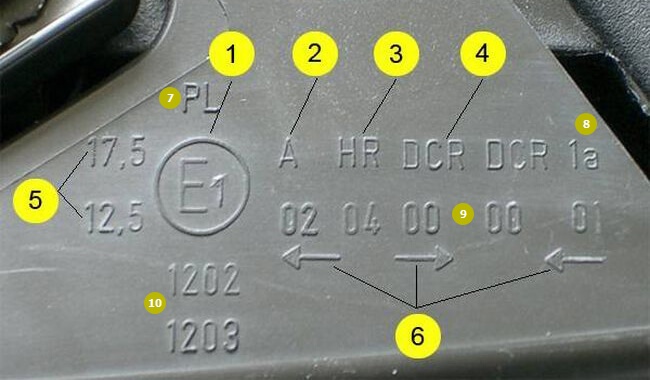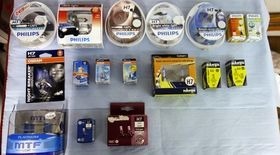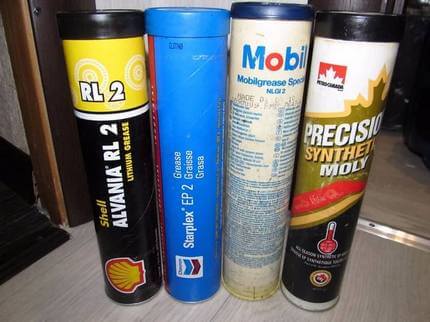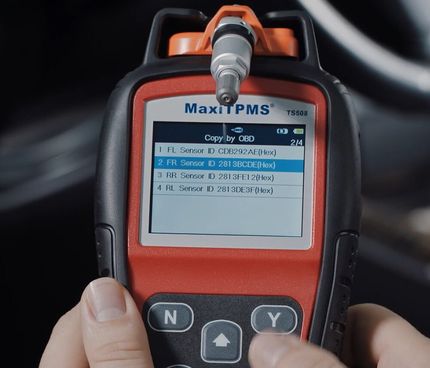
Car headlight marking
Content
headlight markings can give a car owner a lot of information, such as the type of lamps that can be installed in them, their category, the country where the official approval for the production of such headlights was issued, the type of light emitted by them, the illumination (in lux), the direction of travel, and even the date of manufacture . The last element is very interesting in the context of the fact that this information can be used to check the real age when buying a used car. Individual manufacturers of machine headlights (eg KOITO or HELLA) have their own designations, which are useful to know when buying them or buying a car. further in the material, information is provided on a variety of markings for LED, xenon and halogen block headlights.
- International approval mark. In this case approved in Germany.
- The letter A means that the headlight is either a front light or a side light.
- The combination of symbols HR means that if a halogen lamp is installed in the headlight, then only for high beam.
- The DCR symbols mean that if xenon lamps are installed in the lamp, they can be designed for both low beam and high beam.
- The so-called leading basic number (VOCH). Values of 12,5 and 17,5 correspond to low high beam intensity.
- The arrows indicate that the headlight can be used on machines designed for driving on roads with right- and left-hand traffic.
- The PL symbols inform the car owner that a plastic lens is installed on the headlight.
- The symbol IA in this case means that the headlight has a reflector for machine transport.
- The numbers above the arrows indicate the percentages of inclination under which the low beam should be scattered. This is done to facilitate the adjustment of the luminous flux of the headlights.
- The so-called official approval. It speaks of the standards that the headlight meets. The numbers indicate the homologation (upgrade) number. any manufacturer has its own standards, and also complies with international ones.
Headlight markings by category
Marking is a clear, indestructible symbol of international approval, by which you can find information about the country that gave the approval, the headlamp category, its number, the type of lamps that can be installed in it, and so on. Another name for marking is homologation, the term is used in professional circles. usually, the marking is applied to the lens and headlight housing. If the diffuser and the headlight are not included in the set, then the corresponding marking is applied to its protective glass.
Now let's move on to the description of the types of headlights. So, they are of three types:
- headlights for traditional incandescent lamps (now less and less common);
- headlights for halogen lamps;
- headlights for xenon bulbs (they are also discharge lamps / headlights);
- diode headlights (another name is ice headlights).
Incandescent lamps. The letter C indicates that they are designed to glow with low beam, the letter R - high beam, the combination of letters CR - the lamp can emit both low and high beams, the combination C / R means that the lamp can emit either low or high beam (Rules UNECE No. 112, GOST R 41.112-2005).
Halogen lamps. The combination of the letters HC means that it is a low beam lamp, the combination of HR means that the lamp is for driving beam, the combination of HCR means that the lamp is both low and high beam, and the combination HC / R is a lamp for either low or high beam (UNECE Regulation No. 112, GOST R 41.112-2005).
Xenon (gas discharge) lamps. The combination of the letters DC means that the lamp is designed to emit low beam, the combination of DR means that the lamp emits high beam, the combination of DCR means that the lamp is both low and high beam, and the combination DC / R means that the lamp is either low or high beam (Regulations UNECE No. 98, GOST R 41.98-99).
The HCHR marking on Japanese cars means - HID C Halogen R, that is, low xenon, high halogen light.

The best lamps for cars
Find out which bulbs to install in your car's headlights. Ratings are given for popular lamps in h1, h4 and h7 sockets. The lists are compiled based on measurements of the physical indicators of lamps and their characteristics Read more
International Approval Marks
All licensed lamps installed in modern vehicles have some kind of certification. The following standards are most common: the letter “E” corresponds to the European standard, the abbreviation DOT (Department Of Transport - United States Department of Transportation) - the first American standard, the combination of SAE (Society Of Automotive Engineers - Society of Machine Engineers) - another standard according to which , including engine oils.
When marking headlights, as when marking lamps, a specific number is used to designate countries. The relevant information is summarized in a table.
| room | The name of the country | room | The name of the country | room | The name of the country |
|---|---|---|---|---|---|
| 1 | Germany | 13 | Luxembourg | 25 | Croatia |
| 2 | France | 14 | Switzerland | 26 | Slovenia |
| 3 | Italy | 15 | not assigned | 27 | Slovakia |
| 4 | Netherlands | 16 | Norway | 28 | Belarus |
| 5 | Sweden | 17 | Finland | 29 | Estonia |
| 6 | Belgium | 18 | Denmark | 30 | not assigned |
| 7 | Hungary | 19 | Romania | 31 | Bosnia and Herzegovina |
| 8 | The Czech Republic | 20 | Poland | 32 ... 36 | not assigned |
| 9 | Spain | 21 | Portugal | 37 | Turkey |
| 10 | Югославия | 22 | Russian Federation | 38-39 | not assigned |
| 11 | United Kingdom | 23 | Greece | 40 | Republic of Macedonia |
| 12 | Austria | 24 | not assigned | - | - |
Most headlights also bear the logo of the manufacturer or brand under which the product was produced. Similarly, the location of the manufacturer is indicated (often it is simply the country where the headlight was made, for example, Made in Taiwan), as well as the quality standard (this can be either an international standard, for example, ISO, or internal quality standards of one or another specific manufacturer).
Type of emitted light
usually, information about the type of light emitted is indicated somewhere in the name of the circled symbol. So, in addition to the above types of radiation (halogen, xenon, LED), there are also the following designations:
- The letter L. is how the light sources for the rear license plate of the car are designated.
- The letter A (sometimes combined with the letter D, which means that the homologation refers to a pair of headlights). The designation corresponds to the front position lamps or side lamps.
- The letter R (similarly, sometimes in combination with the letter D). This is what the tail light is.
- Combinations of characters S1, S2, S3 (similarly, with the letter D). that's what the brake lights are.
- The letter B. This is how the front fog lights are designated (in the Russian designation - PTF).
- The letter F. The designation corresponds to the rear fog lamp, which is mounted on cars, as well as trailers.
- The letter S. The designation corresponds to an all-glass headlamp.
- Designation of the front direction indicator 1, 1B, 5 - side, 2a - rear (they emit orange light).
- The turn signals also come in a transparent color (white light), but they shine orange due to the orange lamps inside.
- Combination of AR symbols. This is how reversing lights installed on cars and trailers are noted.
- Letters RL. so mark fluorescent lamps.
- A combination of letters PL. Such symbols correspond to headlights with plastic lenses.
- 02A - this is how the sidelight (size) is designated.
It is interesting that cars intended for the North American market (United States of America, Canada) do not have the same designations as European ones, but they have their own. For example, the "turn signals" on American cars are usually red (although there are others). Symbol combinations IA, IIIA, IB, IIIB are reflectors. Symbol I corresponds to reflectors for motor vehicles, symbol III for trailers, and symbol B corresponds to mounted headlights.
According to the rules, on American cars with a length of more than 6 meters, side marker lights must be installed. They are orange in color and are designated SM1 and SM2 (for passenger cars). The taillights emit red light. Trailers must be equipped with a triangular-shaped reflector with the designation ІІІА and contour lights.
Often on the information plate there is also information about the initial angle of inclination, under which the dipped beam should be scattered. Most often it is in the range of 1 ... 1,5%. In this case, there must be a tilt angle corrector, since with different vehicle loads, the headlight illumination angle also changes (roughly speaking, when the rear of the car is heavily loaded, the base luminous flux from the headlights is directed not at the road, but directly in front of the car and even slightly slightly up). In modern cars, usually, this is an electronic corrector, and they allow you to change the corresponding angle directly from the driver's seat while driving. In older cars, this angle must be adjusted in the headlight.
Some headlights are marked with the SAE or DOT (European and American standard of auto manufacturers) standard number.
The value of lightness
On all headlights there is a symbol for the maximum luminous intensity (in lux) that a headlight or a pair of headlights is capable of delivering. This value is called the leading base number (abbreviated as VCH). Accordingly, the higher the VOC value, the more intense the light emitted by the headlights, and the greater the range of its propagation. Please note that this marking is relevant only for headlights with both dipped and high beams.
In accordance with the current rules and regulations, all modern manufacturers are not allowed to produce headlights with a leading base number value exceeding 50 (which corresponds to 150 thousand candelas, cd). As for the total total luminous intensity emitted by all the headlights mounted on the front of the car, they should not exceed 75, or 225 thousand candela. Exceptions are headlights for special vehicles and / or closed sections of roads, as well as sections that are significantly remote from sections of the road used by ordinary (civilian) transport.
Direction of travel
This marking is relevant for cars with a right-hand drive, that is, for one that was originally designed to drive on roads with left-hand traffic. This function is marked with arrows. So, if in the symbol on the headlight an arrow is visible pointing to the left, then, accordingly, the headlight should be installed in a car designed for driving on roads with left-hand traffic. If there are two such arrows (directed both to the right and to the left), then such headlights can be installed on a car for roads with both left-hand and right-hand traffic. True, in this case, additional adjustment of the headlights is necessary.
However, in most cases, the arrows are simply missing, which means that the headlight must be installed on a car designed to drive on right-hand traffic roads. The absence of an arrow is due to the fact that there are more roads with right-hand traffic in the world than left-hand traffic, similarly with the corresponding cars.
Official approval
Many headlights (but not all) contain information about the standards that the product complies with. And it depends on the specific manufacturer. usually, the standardization information is located below the symbol within the circle. Typically, information is stored in a combination of several numbers. The first two of them are the modifications that this headlight model has undergone (if any, otherwise the first digits will be two zeros). The remaining digits are the individual homologation number.
Many motorists are interested in the question of where exactly you can see information about the marking of new or already installed headlights on the car. Most often, the relevant information is applied to the upper part of the headlight housing, namely, under the hood. Another option is that the information is printed on the glass of the headlight from its inner side. Unfortunately, for some headlights, the information cannot be read without first dismantling the headlights from their seat. It depends on the specific car model.
Marking xenon headlights
In recent years, xenon headlights have become very popular with domestic motorists. They have a number of advantages over classic halogen light sources. They have a different type of base - D2R (the so-called reflex) or D2S (the so-called projector), and the glow temperature is below 5000 K (the number 2 in the designations corresponds to the second generation of lamps, and the number 1, respectively, to the first, but they are currently found infrequently for obvious reasons). Please note that the installation of xenon headlights must be carried out correctly, that is, in accordance with the current rules and regulations. Therefore, it is better to install a xenon headlight in a specialized car repair shop.
The following are specific designations for halogen headlights, with which it is possible to determine whether xenon light can be installed instead:
- DC/DR. In such a headlight there are separate sources of low and high beams. Moreover, such designations can also take place on gas-discharge lamps. Accordingly, instead of them, you can put "xenons", however, in accordance with the rules mentioned above.
- DC/HR. Such headlights are designed to be fitted with gas-discharge lamps for low-profile lighting. Accordingly, such lamps cannot be installed on other types of headlights.
- HC/HR. This marking is installed on the headlights of Japanese cars. It means that instead of halogen headlights, xenon ones can be mounted on them. If such an inscription is on a European or American car, then the installation of xenon headlights on them is also prohibited! Accordingly, only halogen headlights can be used for them. And this applies to both low beam and high beam lamps.
Sometimes numbers are written before the symbols mentioned above (for example, 04). This figure indicates that changes have been made to the documentation and design of the headlights in accordance with the requirements of the UNECE Regulation with the number indicated before the mentioned symbols.
As for the places where information about the headlight is applied, xenon light sources can have three of them:
- precisely on the glass from its inside;
- on top of the headlight cover, made of glass or plastic, to study the relevant information, you usually need to open the hood of the car;
- on the back of the glass cover.
Xenon lamps also have a number of individual designations. Among them are several English letters:
- A - side;
- B - fog;
- C - dipped beam;
- R - high beam;
- C / R (CR) - for use in headlights as sources of both low and high beams.
sticker for xenon headlights
Samples of various stickers
Recently, among motorists, on whose cars xenon headlights are installed not from the factory, but during operation, the topic of self-production of stickers for headlights is gaining popularity. namely, this is true for xenons that have been reworked, that is, normal xenon lenses have been replaced or installed (for optics without changes, the corresponding sticker is made by the manufacturer of the headlight or car).
When making stickers for xenon headlights yourself, you must know the following parameters:
- What kind of lenses were installed - bilenses or ordinary mono.
- The bulbs used in the headlight are for the low beam, for the high beam, for the turn signal, running lights, the type of base, and so on. Please note that for Chinese Plug-n-play lenses, the Chinese lens and halogen base (type H1, H4 and others) cannot be indicated on the sticker. also, during their installation, it is imperative to hide their wiring, since by their appearance (installation) one can easily identify such devices, and get in trouble when checking by employees of the State Road Service.
- Geometric dimensions of the sticker. It should fit completely on the headlight housing and give full information when looking at it.
- Headlight manufacturer (there are a lot of them now).
- Additional information, such as the date of manufacture of the headlights.
Anti-theft marking headlights
Like windshields, car headlights are also marked with a so-called VIN number, the task of which is to identify a specific glass in order to minimize the risk of headlight theft. This is especially true for expensive foreign cars of world famous manufacturers, the cost of headlights of which is quite high, and analogues either do not exist or they also have a considerable price. The VIN is usually engraved on the headlight housing. Identical information is entered in the technical documentation of the car. Accordingly, when checking the configuration of the car of a traffic police officer, if the code value does not match, they may have questions for the car owner.
it is the VIN code that is a seventeen-digit code consisting of letters and numbers, and is assigned by the car manufacturer or the manufacturer of the headlight itself. This code is also duplicated in several places on the car body - in the cabin, on the nameplate under the hood, under the windshield. Therefore, when buying certain headlights, it is advisable to choose light sources on which the VIN code is clearly visible, and all information about the product is known.

